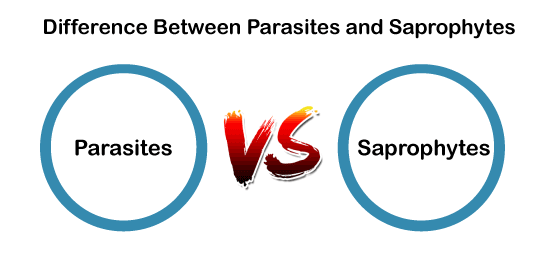Difference between Parasite and SaprophyteThere are various organisms on this earth. Cells, plants, animals, bacteria, etc., are some of the classified life forms. All these organisms feed on one another for sustenance. Some organisms can be fatal as the host organism can die in the process. However, today we will be discussing about the two organisms, i.e., parasites and saprophytes out of these several organisms. Now, what are parasites and saprophytes? And what are the significant contrasting points between them? Well, parasites and saprophytes are single-celled or multiple-cell organisms that feed on their host for survival. So, let us begin by understanding the primary meaning of these terms. 
ParasitesA parasite is defined as an organism that resides or feeds upon the host organism. The food is obtained by the parasite. Now, a parasite can be a plant or an animal organism that can live on another plant or animal for nourishing itself. There are three significant kinds of parasites, namely, protozoa, ectoparasites, and helminths. There are several diseases associated with the parasites. Particularly infections are seen on the host organism that has been affected by the parasites. Examples of parasites include fleas, tapeworms, fungus, mites, ticks, leeches, etc. Parasites harm the organisms resulting in their death. Parasites are also seen in humans. They enter into the human body through contaminated water, food, uncooked food, especially meat, etc. Due to these parasites, the human body can suffer from chronic ailments and allergies. Now, how to get rid of these parasites? Well, these parasites can diminish or disappear on their own if the immune system of the host is quite well. If the parasites do not go on their own, then one can take help from the doctors. The doctors generally prescribe oral medication. Through this, the parasites can diminish and disappear. SaprophytesSaprophytes are defined as the organisms that feed on the dead organisms for their survival. Saprophytes are found in decaying plants and animals. Saprophytes are also known as decomposers as they feed on dead matter or organisms. They are heterotrophs who are the consumers in the food chain. Examples of saprophytes include yeast, cheese, mold, fungi, etc. Saprophytes are generally the fungal and bacterial organisms that feed on the dead. The word 'saprophytes' has come from the Greek word 'sapros' and 'trophe,' meaning 'rotten' and 'nourishment,' respectively. Saprophytes are one of the important organisms in soil biology. They are used for breaking complex matters into simpler substances. These substances are then taken by the plants for their activities. Now, let us look at some of the differences between saprophytes and parasites.
So, these are some of the significant points of contrast between parasites and saprophytes. The major difference among them is that of feeding. Both gain nutrition through different processes. Now, there are several kinds of parasites and saprophytes. So, let us take a look at them. Types of Parasites
Types of Saprophytes
So, these are some of the types of parasites and saprophytes. Well, there are many features of parasites and saprophytes. Out of these, the major feature is that parasites feed on the living, while saprophytes live on the dead and decaying matter. So, let us look at some of the characteristics of parasites. Characteristics of Parasites
Characteristics of Saprophytes
So, these are the characteristics of parasites and saprophytes. Both these organisms feed on others for their survival. Thus, both parasites and saprophytes are the living organisms that are prokaryotic and eukaryotic cells feeding on other living/ dead organisms.
Next Topic#
|
 For Videos Join Our Youtube Channel: Join Now
For Videos Join Our Youtube Channel: Join Now
Feedback
- Send your Feedback to [email protected]
Help Others, Please Share










